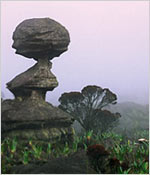|
|
| Help | |
| You are here: Rediff Home » India » Get Ahead » Leisure » Travel |
|
 Tepui (Tabletop) Mountains, Venezuela | |||||
| Related Articles | |||||
|
•
India's top wildlife safaris
| |||||
| |||||||||||||||||||||||
|
| |||||||||||||||||||||||
The Alps are gorgeous. So are the Rockies and the Himalayas. But if shown a picture of one of them, could you tell which it was? That's not a problem when it comes to Venezuela's tepui mountains, giant tables of stone that rise thousands of feet out of the jungle, teeming with prehistoric plants and animals found nowhere else in the world.
How about beaches? Maui's nice. So is Sydney. But Namibia's Skeleton Coast is littered with shipwrecks from the thousands of captains that got lost in its ever-present fog. Its ochre dunes climb high into the distance, interrupted only by the footprints of hardy antelopes that can survive with less than half an inch of rain a year. You may not want to suntan there, but there's no chance of mistaking it for somewhere else.
In Pictures: 10 Astonishing Landscapes
- Also see: 10 Most Beautiful Skydives
- Also see: America's 25 Most Visited Tourist Sites
There are beautiful landscapes, and then there are unique landscapes -- instantly recognizable views that are found nowhere else in the world. This planet has more than 57 million square miles of land, shaped by geological forces and the weather. The terraforming tools are the standard set: uplift, faulting, folding, wind, water, rain, ice. The truly unique situations come about, however, from geological outliers -- like the drying up of the giant prehistoric Lake Minchin to form the world's largest salt flatin Uyuni, Bolivia, at 12,000 feet. Unique landscapes can be some of the most compelling reasons to take a trip; by their very nature, they provide views and experiences you can't find anywhere else.
Although vast and formed by stone, wood and water, unique landscapes, like many landscapes around the world, are vulnerable. The main issue, according to Dr Mechtild R�ssler, chief of Europe and North America for the UNESCO World Heritage Centre, is the sheer scope of space to be protected. "If you deal with a single monument then you write to the site manager of the single monument," says Dr R�ssler. "If you deal with a cultural landscape, you have many, many more stakeholders and that is evidently more difficult."
The traditional conservationist's nightmare is a single company with a few chainsaws and sticks of dynamite undoing works it took nature hundreds or millions of years to create. But with a growing world population and a changing climate, the challenges these days come from many directions.
In Pictures: 10 Astonishing Landscapes
- Also see: The Seven Modern Wonders of the World
- Also see: The New Versailles
In 1850, old-growth Redwood trees covered around 3,000 miles of the California coast. Today, less than 10 percent of those remain at heights of nearly 400 feet and 2,000 years of age, but they are enough to make visitors feel dwarfed in ways they could only otherwise be by mountains or skyscrapers. But global warming threatens to change climates all over the world, including the regular clouds of fog that coastal redwoods rely upon for their growth and continuance. Scientists are just beginning to study the potential effects.
Even alternative energy activists with their solar and wind farms are proving to be dangerous to the integrity of unique landscapes. The highlands of Scotland are low by mountain standards, but relatively treeless, making them as craggy and dramatic as many much taller ranges. But the United Kingdom, like the rest of the world, is feeling the energy crunch, and Scotland, with its vast open spaces, is positioning itself as a green energy capital of Europe. Unfortunately, that means wind farms -- lots of them -- populating the landscape with giant windmills where once mythical giant warriors roamed. The struggle is pitting landscape conservationists against green energy activists -- groups both interested in environmental preservation but divided on what that means.
In general, Dr R�ssler says, UNESCO encourages the greening of their World Heritage sites. The key is to be careful in the placement. "You need to avoid the obstruction of important views which may be not only important for local communities but which may be iconic views for people all around the world," she says.
Still, it is useful to keep in mind that the Earth formed these beautiful places, and in time through its own processes it will take them away. One prime force of both creation and destruction of unique landscapes is erosion. Rocks with differing resistance to water often combine to form some of nature's most fantastic works, like the fairy chimneys of Cappadocia, Turkey. There, basalt capstones protect spires of powdery tuff, creating a moonscape of beige rock towers with dwellings carved into them. But once the basalt capstones fall off, the towers erode quickly. The unique views that tourists can experience today are only snapshots of larger processes outside our control.
"The Earth has been changing in very large ways for 4.5 billion years. It will continue to change, no matter what we do and what we think is good or bad," said Robert L Reuss, a professor of geology at Tufts University. He points out that while we worry about rising sea levels, the Gulf of Mexico once came as far north as Illinois. "In the long view, the Earth will recover just fine."
In Pictures: 10 Astonishing Landscapes
- Also see: Luxurious Lakeside Resorts
|
|
| © 2008 Rediff.com India Limited. All Rights Reserved. Disclaimer | Feedback |